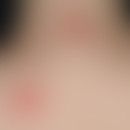HistoryThis section has been translated automatically.
The first water-soluble organic iodine compounds were used as contrast agents in 1929. Both the range of applications and the composition of contrast media have changed considerably since then (Leissner 2010).
DefinitionThis section has been translated automatically.
A contrast agent is a substance that is used for X-ray, MRI and ultrasound examinations. Contrast agents change the image contrast of the respective image (ESUR guidelines 2018).
You might also be interested in
ClassificationThis section has been translated automatically.
A distinction is made between contrast media
- iodine-containing
- Gadolinium-containing
- Barium-containing
- Containing air
- Contrast media containing carbon dioxide (ESUR guidelines 2018)
Adverse effects after administration of contrast media are divided into:
- Grade 1:
Mild reaction with mild itching, urticaria and erythema. Nausea, vomiting, feeling cold, feeling warm, anxiety and vasovagal reactions may occur (ESUR guidelines 2018). They occur in approx. 1% of patients (Manski 2024).
- Grade 2:
A moderate reaction is found with clearly visible urticaria, facial or laryngeal edema and mild bronchospasm (ESUR guidelines 2018). Such reactions occur in 0.1-1 % (Manski 2024).
- Grade 3:
Arrhythmias and hypotensive shock may occur (ESUR guidelines 2018)
- Grade 4:
A severe reaction results in respiratory and cardiac arrest. Seizures may also occur (ESUR guidelines 2018). Life-threatening reactions occur in 0.1-0.01% of patients. The mortality rate is 1:1,000,000 (Manski 2024).
Patients should always be monitored in the radiology department for 30 minutes after contrast medium administration. Emergency medication and equipment must be kept ready for emergencies (ESUR guidelines 2018).
General informationThis section has been translated automatically.
I. Contrast media containing iodine:
The risk of adverse effects is greatest with contrast media containing iodine (ESUR guidelines 2018).
These are the 1st generation of contrast media. They are high-osmolar contrast media and may no longer be administered intravenously nowadays. Low-osmolar iodine-containing contrast media (LOCM) are now also used (Manski 2024).
With iodine-containing contrast media, allergic reactions can occur without prior sensitization or cause type I allergies after previous sensitization (Manski 2024).
Another form of allergic reaction is the so-called breakthrough reaction (BTR), in which an allergic reaction occurs despite premedication. BTR is an absolute contraindication for contrast media (Böhm 2017).
- Contraindications for iodine-containing contrast media are:
- Hyperthyroidism
- Allergy to iodine
- Renal insufficiency, as from a creatinine value of > 3-4 mg/dl the renal accumulation of contrast medium is only low
- Liver insufficiency
- IgM paraproteinosis, as there is then a risk of kidney failure (Herold 2018)
- Exsiccosis (Manski 2024)
- Breakthrough reactions, i.e. allergic reactions to contrast media after premedication (Böhm 2017)
- Allergic risk profile
Patients with an allergic risk profile should receive oral or intravenous premedication.
- Oral medication:
This should be given 12 h before contrast medium administration and consists of:
- Prednisolone 30 mg, 12h, 6h and 1h before the X-ray exposure
- Fenistil 1 mg 12h and 1h before the planned exposure
- Cimetidine 200 mg 12h and 1h before administration of the contrast medium (Manski 2024)
- Intravenous premedication:
This consists of:
- Prednisolone 100 mg i. v.
- Fenistil 0.1 mg/kg/KG slowly i.v.
- Cimetidine 200 mg slowly i.v. before administration of the contrast medium (Manski 2024)
- Prophylaxis to prevent damage when administering iodine-containing contrast media:
- The patient should be sufficiently hydrated before administration of an X-ray contrast medium in order to avoid renal complications
- Patients with impaired renal function should be given acetylcysteine orally before contrast medium administration (Herold 2018)
II Contrast media containing gadolinium:
Gadolinium is a paramagnetic substance that generally appears bright on T1-weighted images. Gadolinium accumulates in the spleen, liver and bones and absorbs X-rays. Existing renal insufficiency or hyperthyroidism are not affected by gadolinium, although patients with renal insufficiency excrete gadolinium more slowly (Kauffmann 2013).
Contrast agents containing gadolinium are used in MRI and X-ray examinations.
- Contraindications:
III Ultrasound contrast media:
These are usually very safe (ESUR guidelines 2018).
- Contraindications for ultrasound contrast media:
- Patients should not receive contrast media 24 hours before extracorporeal shock wave therapy ((ESUR Guidelines 2018)
IV. Contrast media containing barium:
- Contraindications:
- Intestinal wall integrity is impaired
- Known allergic reaction to barium-containing contrast media (ESUR guidelines 2018)
LiteratureThis section has been translated automatically.
- Böhm I, Nairz K, Endrich O, Hasembank S, Keller P, Heverhagen J (2017) Are so-called "breakthrough" reactions (BRT) after premedication in contrast media allergy a contraindication for contrast media? Rofo (189) 1- 124
- ESUR guidelines (2018) ESUR guidelines for contrast media (European Society of Urogenital Radiology) Version 10.0
- Herold G et al. (2018) Internal medicine. Herold publishing house 605
- Kasper D L, Fauci A S, Hauser S L, Longo D L, Jameson J L, Loscalzo J et al. (2015) Harrison's Principles of Internal Medicine. Mc Graw Hill Education
- Kauffmann G W, Rau W S, Roeren T, Sartor K (2013) Röntgenfibel: Praktische Anleitung für Eingriffe in der Röntgendiagnostik und interventionellen Radiologie. Springer Verlag Berlin / Heidelberg / New York 549
- Leissner G, Lewentat G. (2010) X-ray and MRI contrast media: side effects and contraindications. Radiopraxis (3) 123-136
- Manski D (2024) Urologielehrbuch.de Iodine-containing contrast media: side effects, contraindications and dosage. Doi: https://www.urologielehrbuch.de/jodhaltige_kontrastmittel.html



